The long days of June have found us. If all other needs are met, plant growth rate is determined by a combination of both light and temperature. Which is a round about way of saying, I hope the long-awaited summer temperatures combined with June’s long days will soon have crop growth coming on like gangbusters!
The cool spring seems to have kept insect pressures relatively low, but warmer temperatures can cause population growth and feeding activity to increase for several pests. Onion thrips are being reported in Massachusetts, below the treatment threshold of one per leaf, except in some overwintered onions, which seem to have provided them a chance to build up their population to high levels. Striped cucumber beetles have also emerged and are starting to be seen in cucurbit plantings. As briefly mentioned in the last report, imported cabbageworm moths are flying. Overwintered Colorado potato beetles have emerged as adults, showing up around New England, and the first generation of larvae have already been seen feeding in Long Island. Leafminers are likely becoming active and laying eggs on spinach/beets/chard. You can find our discussion of this topic in the MOFGA Pest Reports 2019 Archive.
In this issue:
Garden Springtails
Onion Thrips
Imported Cabbageworm
Striped Cucumber Beetle
Colorado Potato Beetle
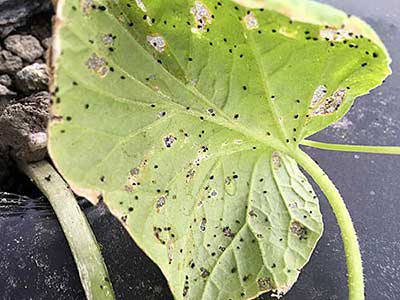 |
| Garden springtails on cucumber |
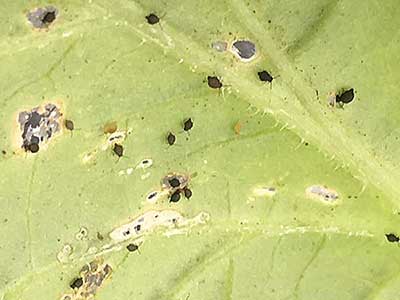 |
| A closer view of garden springtails on cucumber |
GARDEN SPRINGTAILS
Springtails (Collembolla) are a very diverse group of soil dwelling arthropods, that largely feed on decaying organic matter. As such, most springtail species are playing a beneficial role in a healthy soil’s food web. That knowledge may be of little relief, however, if your young crop is one of the rare victims beset upon by large numbers of the garden springtail, Bourltiella hortensis.
At a glance, garden springtails and their damage resemble very much that of flea beetles, but springtails lack wings and are not true insects. They can be pale yellow to dark brown or gray. One defining feature of springtails is a tail-like appendage at the tip of their abdomen that they can use to launch themselves into the air, which is also the source of their name. Because they can’t actually fly, and because they favor tender young leaves, damage is typically restricted to cotyledons, and the first few true leaves low to the ground. Garden springtails are generalists and have been found feeding on squash, cucumber, beets, chard, beans, and even onions. However, the only reports of significant damage in New England that I’ve been made aware of are on young cucurbit transplants such as squash and cucumbers.
Though severe damage is very rare, large populations could set back young seedlings or even result in crop failure in extreme cases. Springtail lifecycles are short (less than 3 weeks from egg to sexual maturity), and females can lay up to 400 eggs in their lifetime, so populations could build up fairly quickly under favorable conditions. Conditions favorable to springtails are high in decaying organic matter and with protection from drying out, as they require fairly humid surroundings.
Management begins with common best practices; good sanitation to limit habitat, improved airflow to facilitate drying out between waterings, keeping greenhouse trays elevated on benches, and planting out vigorous seedlings that will grow past susceptible stages quickly. Spraying garlic on lower leaves has been suggested to deter garden springtails, though I cannot vouch for its efficacy. As a last resort, PyGanic is labeled for springtails.
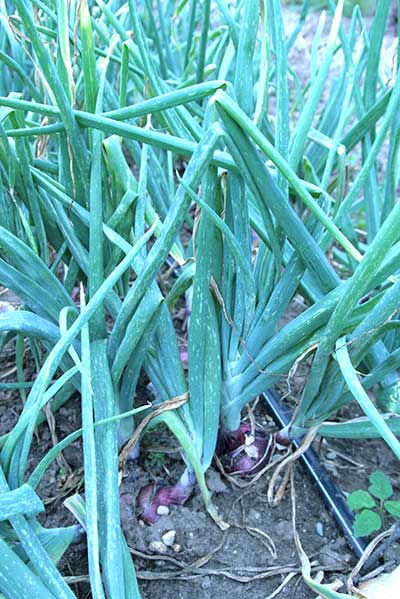 |
| Damage to onion leaves caused by thrips |
ONION THRIPS
by Eric Sideman
Onion thrips are active already, and if they have been a problem for you in years past it is time to start scouting for them. They are very tiny and easily overlooked until the onion plants start showing leaves that look as if they have been rasped. In fact they have. The thrips feed by using their mouth parts to rasp and pierce the onion leaves, releasing juices for them to feed upon. If the population of thrips is large you will see silvery patches on all the young leaves and when really bad the whole field will look white and silvery and the leaves wither. Obviously onion yields can be greatly reduced because the onion plant loses food and water through the damaged tissue. It is best to get control of them before their populations grow.
Onion thrips hide between the leaves at the base of the onion plant. I find the best way to find them is to pull up a plant and hold it upside down over a white sheet of paper and pull apart the leaves as you shake gently. Even when they are walking about on the paper you will still need to look hard to see the thrips. My eyes are not that good and I need a hand lens to even spot them. Immature thrips are white to a pale yellow, elongated with very short antennae and dark eyes. Remember, tiny. The adult is tiny too, but it has wings. Thrips’ wings are unique. They are fringed with hairs. Thrips are very poor fliers, but they do fly when disturbed, and they do get blown in the wind easily, so they may move long distances. Keep in mind that this means thrips can be blown to new fields downwind. Adults are pale yellow to dark brown.
There are many generations per season and they can reproduce very quickly in warm weather. Also, parthenogenesis is common, meaning females that cannot find males produce progeny all by themselves. Each female can produce up to 80 eggs, which tells you that the population can explode quite quickly under good conditions. Good conditions are warm and without heavy rains. Heavy rains wash the weak insect off the plant. Growers can simulate heavy rains with heavy overhead irrigation. As well as disturbing the insect, the extra water will help the rasped onions. Extra fertilization will help too.
Thrips survive in onion and garlic debris so clean up after harvest. Also, thrips hide in the garlic bulb for the winter, so you may have “planted” them when you planted the garlic in the fall. I have heard that thrips are confused by inter-cropping with carrots, and have a harder time finding your crop.
If natural enemies or cultural practices fail to keep thrips populations down then you may need to turn to a pesticide. Remember, thrips are often around in small numbers which can be tolerated. IPM practices recommend an economic threshold of an average of 1 thrips per green leaf. When scouting, sample about 50 plants around the field from at least 10 different locations in the field and then figure the average per leaf. Entrust is the most common recommended material. Follow the label instructions and be sure to spray into the leaf axis. Surround is reported to deter thrips, and may be the better choice if you have had bad thrips problems in the past. See the summer 2013 edition of The Maine Organic Farmer & Gardener for an excellent article about onion thrips by Tom Vigue.
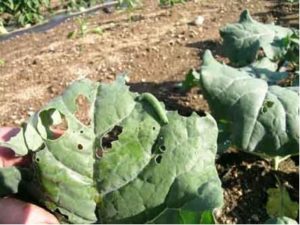 |
| Imported cabbageworm and feeding damage |
IMPORTED CABBAGE WORM
By Eric Sideman
Finding the white moth with the dark marks on its wing flying in large numbers around brassica vegetables is a troubling sight. You may find the eggs they lay, and the tiny caterpillars that hatch. I only notice them after I see the holes and chunks chewed out of the leaves. It is much better to spot them early, so scout often. Even if you cannot see the eggs, it is much easier to manage them when they are still tiny caterpillars.
The pest overwinters as a pupa in crop debris and is a common pest every year. The imported cabbage worm is the most common of three different caterpillars often found feeding on cabbage, broccoli, Brussels sprouts, kale, etc. The other two caterpillars often seen feeding on brassica crops are the diamondback moth and the cabbage looper. The looper does not overwinter in the north, and any overwintering of the diamondback is spotty at best. These pests are usually carried up here by storms. Hence problems from these pests vary from year to year, and are usually less common than the imported cabbageworm.
All three pests produce multiple generations each growing season. It is important to destroy the crop debris after harvest so as not to harbor future generations that will move onto your later plantings. Controlling brassica weeds will help. Row covers will work however these crops do not do well in heat so there could be problems in warmer weather, unless you switch over to exclusion netting which allows greater air-flow.
Bt gives good control of all three caterpillars, if applied while they’re still young enough to be feeding. Dipel is a common brand. Spinosad works even better, but is more expensive. Be sure to scout the crops and spray only when the pest is present. Bt must be eaten to work and since it degrades quickly in sunlight it should be sprayed when the pest is actively feeding. There is no protective activity. As usual, if you are a certified grower be sure that the formulation you use is approved for organic production.
By the way, the imported cabbage worm also feeds on lettuce.
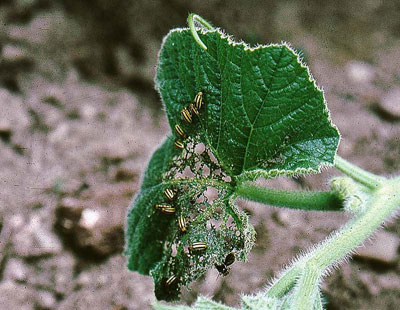 |
| Cucumber beetles and feeding damage |
STRIPED CUCUMBER BEETLE
Striped cucumber beetle is our most serious early-season pest in cucurbit crops. These beetles spend the winter in plant debris in field edges and with the onset of warm days and emergence of cucurbit crops they move rapidly into the field. Densities can be very high, especially in non-rotated fields or close to last year’s cucurbit crops. Adult feeding on cotyledons and young leaves can cause stand reduction, delayed plant growth, and reduced yield. The striped cucumber beetle also vectors Erwinia tracheiphila, the causal agent of bacterial wilt, and this can be much more damaging than direct feeding injury. Crop rotation, transplants, and floating row cover are cultural controls that help reduce the impact of cucumber beetles. Many growers use row covers on cucurbits for both growth benefit and insect protection, and remove when flowering begins. I remove the covers when I see the first female flower.
Avoid early season infection with wilt. Cucurbit plants at the cotyledon and first 1-2 leaf stage are more susceptible to infection with bacterial wilt than older plants, and disease transmission is lower after about the 4-leaf stage. Using row covers to keep the beetles out at this most vulnerable stage can be very effective.
Beetle numbers should be kept low, especially before the 5-leaf stage. Scout frequently (at least twice per week before emergence, and for two weeks after crop emergence) and treat after beetles colonize the field. The threshold depends on the crop. To prevent bacterial wilt in highly susceptible crops such as cucumber, muskmelons, summer squash, and zucchini, we recommend that beetles should not be allowed to exceed one beetle for every 2 plants. Less wilt-susceptible crops (butternut, most pumpkins) will tolerate 1 or 2 beetles per plant without yield losses. Spray within 24 hours after the threshold is reached.
Insecticides that are allowed in organic production (listed by OMRI, the Organic Materials Review Institute) include kaolin clay (Surround WP), pyrethrin (PyGanic Crop Spray 5.0 EC), and a mixture of pyrethrin and azadiractin (Azera). Surround should be applied before beetles arrive because it acts as a repellent and protectant, not a contact poison. With direct-seeded crops, apply as soon as seedlings emerge if beetles are active. Transplants can be sprayed or dipped before setting out in the field.
Perimeter trap cropping with a preferred cucurbit crop (usually a C. maxima such as ‘blue hubbard’ or ‘buttercup’) can give excellent control with a dramatic reduction in pesticide use. For details on using perimeter trap cropping, see Connecticut IPM Program’s Directions For Using a Perimeter Trap Crop Strategy to Protect Cucurbit Crops.
(Modified from the UMass. Vegetable Newsletter, original written by Ruth Hazzard & Andrew Cavanagh)
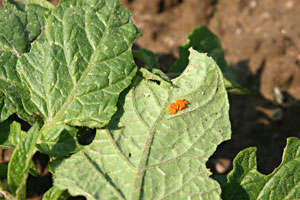 |
| Colorado potato beetle eggs |
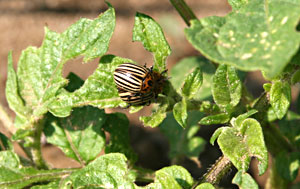 |
| Adult Colorado potato beetle |
COLORADO POTATO BEETLE
Colorado potato beetle (CPB) adults are starting to show up in potato and eggplant crops. The bright orange-yellow eggs are laid in clumps with about 30-35 eggs each, generally on the undersides of leaves. As with most other insects and plants, there is a direct relationship between higher temperatures (in the range between about 55 and 90 degrees F) and faster rate of development. That includes egg-laying, egg hatch, larval growth, and feeding rates. A period of cold, rainy weather slows everything down, but we can expect a surge of adults and shiny yellow eggs to appear with the next hot spell.
Scouting and Thresholds
Walk your fields NOW and look for CPB adults and eggs. A treatment should be considered for adults when you find 25 beetles per 50 plants and defoliation has reached the 10% level. The spray threshold for small larvae is 4 per plant; for large larvae, 1.5 per plant (or per stalk in midseason), based on a count of 50 plants or stalks.
Controls are needed on eggplants when there are 2 small or 1 large larvae per plant (if plants are less than six inches) and 4 small larvae or 2 large per plant (if plants are more than six inches).
Potatoes can tolerate 20% defoliation without reduction in yield (or even more late in the season). Damage to eggplant seedlings from adult feeding is often severe enough to warrant control of the adults. In potato, adult damage in rotated fields may not be significant, so you may be able to wait until after egg hatch to kill both late adults and larvae.
Look on the undersides of leaves for the orange-yellow egg masses. The fresher the eggs, the brighter orange the eggs will appear. Eggs hatch in 7-10 days, depending on temperature. If you want to know when the earliest eggs are hatching, you can flag a few of the earliest egg masses you find with bright tape or flags, and then keep an eye on the hatch.
Hatched larvae go through four stages before they become adults. In the first stage, the larvae are about the same size as the eggs and in the second stage they are about an eighth of an inch long. As the larvae get bigger, they do more feeding. The fourth, or largest, stage does 85% of the feeding damage. It’s a good idea to prevent larvae from ever reaching the fourth instar! The smaller instars are the easiest to kill.
After larvae complete their growth, they drop to the ground and burrow into the ground to pupate. About ten days later, the next generation of adults emerges – ready to feed. If they emerge before August 1, they will lay more eggs. After August 1, they feed and head to overwintering sites. Good control in June prevents problems with CPB in August.
Cultural Controls
Crop Rotation. The single most important tactic for CPB management is to rotate potatoes or eggplant to a field that is at least 200 yards from the previous year’s fields. Since the adults that emerge after winter rarely fly, barriers such as roads, rivers, woodlands, and fields with other crops are helpful. Rotated fields tend to be colonized (from second generation adults that are likely to fly) 1-4 weeks later in the season than non-rotated fields. Also, the total population of adult beetles is lower, producing fewer larvae to control.
Perimeter treatments or perimeter trap cropping can be applied to potato. One approach is to plant a barrier crop between overwintering sites and this year’s crop and get it in earlier than the main crop; then control early-arriving beetles.
Early planting. Green sprouting, also know as chitting, prepares whole seed potatoes to emerge rapidly, gaining about 7-10 days to harvest. This early start makes it easier for the crop to put on growth and size before CPB adults and larvae arrive. It can be combined with raised beds and plasticulture. While it won’t avoid damage altogether, it may reduce the need for insecticides. Refer to the New England Vegetable Management Guide for more details.
Late planting. Another strategy for beating the beetle is to plant late. CPB adults that do not find food leave the field in search of greener pastures. Planting after mid- June, using a short season variety, often avoids CPB damage and eliminates the need for controls.
Straw mulch. It has been well documented that when potato or eggplants are mulched with straw, fewer Colorado potato beetle adults will settle on the plants and fewer eggs will be laid. This can be accomplished on larger plantings by strip planting in a rye mulch, followed by mowing and pushing the rye straw over the plants after they emerge. For smaller plots, straw may be carried in.
Biological control. There are numerous predators and parasitoids that attack CPB adults, larvae, and eggs including a tachinid fly, 12-spotted ladybeetle, spined soldier bug, and ground beetles.
Organic materials
Spinosad (Entrust) and azadiractin (AZA-Direct) are two options. Studies have shown very good results with spinosad, but please use reluctantly because resistance is building up in populations of CPB. The azadiractin has shown some efficacy, but neem works slowly. Generally it is used to reduce overall damage and reduce numbers but it is not a rescue treatment like spinosad is. Beauvaria bassiana (Mycotrol ESO) has been shown to suppress CPB populations though does not provide immediate control.
NOTE: There are label restrictions on the use of Entrust that have been written in to help avoid build up of resistance. Be sure to follow the label with respect to mixing, AND number of times a particular crop may be sprayed per season.
(Modified from the Umass Vegetable Notes, an article by – R Hazzard; (sources include: D Ferro (UMass Amherst), J. Mishanec (NYS), J Boucher (CT), J. Whalen (DE), T. Kuhar (VA), G Ghidhu (NJ), New England Vegetable Management Guide, Ohio Vegetable Production Guide)

